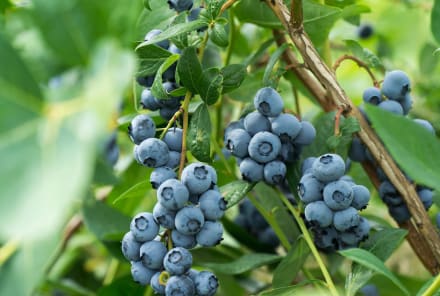Advertisement
Yes, Squirting Is Real: The Research On Female Ejaculation & What Squirt Is


For anyone who's never experienced squirting or seen a partner do it, it can be easy to assume it's all just a myth perpetuated by porn.
But squirting is definitely real, and it may even be somewhat common.
We dug into the research and spoke with Zhana Vrangalova, Ph.D., a professor of sexuality at New York University and sex researcher who has been extensively studying squirting, and Good Vibrations sexologist Carol Queen, Ph.D., to understand what squirt is exactly.
Is squirting real?
Yes, squirting is real. A 1984 study found 54% of women have experienced an "orgasmic expulsion of fluid1" at least once in their life and 14% experience it almost every time they orgasm.
A 2017 cross-sectional study found 69% of women between ages 18 and 39 had experienced ejaculation during orgasm.
"It definitely is not a myth. It exists. It's real," Vrangalova confirms. "However, exactly what it is and where it comes from is still a bit of a mystery."
Summary
What is squirting?
Squirting is a colloquial term used to describe when a person with a vulva releases a specific type of fluid from the urethra or vulva area in response to sexual stimulation.
The liquid released during squirting is usually as clear as water2, colorless and odorless, and it sometimes comes out gushing in relatively large quantities.
There is no consensus among sexual health professionals as to what squirt is, though research has found it can contain some of the same components as urine3 and some of the same components as semen.
Squirting can feel pleasurable and sometimes coincides with an orgasm, though not always.
The vast majority of vagina owners are likely capable of squirting with the right kind of stimulation and timing, according to Vrangalova, though there's a lack of sufficient research to definitively prove it.
Summary
Squirting vs. female ejaculation
The terms "squirting" and "female ejaculation" are often used interchangeably, but some research and experts use these terms to describe two separate types of ejaculate.
Squirting is used to describe the release of a fluid that's clear and colorless, shares some of the same properties as urine, and likely comes from the bladder.
Female ejaculation is used to describe the release of another kind of fluid that is often white and milky, contains prostate-specific antigens (PSAs) and other chemicals found in semen, and likely originates from the Skene's glands.
The Skene's glands, sometimes called the "female prostate," are a set of glands embedded in some vagina owners' urethral walls (or the area around the urethra, sometimes called the urethral sponge, which is also where the so-called G-spot is said to be located). These glands are thought to be homologous to the prostate4 in people with penises, meaning they have similar functions. The prostate (also sometimes called the "male G-spot") secretes a fluid that contributes to semen.
Squirting usually involves a larger amount of fluid being released, sometimes described as "gushing" or "geyser-like," whereas female ejaculation alone is usually a pretty small amount of fluid.
These two types of ejaculation can happen independently of one another or at the same time. As such, Vrangalova says some studies conflate the two, making it hard to interpret their results.
Even experts don't agree on the exact terminology, and some experts believe using two different terms isn't appropriate. Instead, they believe it's more accurate to say that there is ejaculation (which is the same as squirting), and then there is pee.
Summary
Is squirting pee?
Experts disagree on whether squirt is pee. Some components of urine have been found in squirt, including urea, creatinine, and uric acid concentrations, though it's also been found to contain PSAs and other chemicals found in semen5, likely from the Skene's glands.
Some biochemical analyses have found it to be a unique substance different from urine despite some similarities. The clear liquid produced during some instances of squirting (the more "gushing" type) does likely come from the bladder or at least passes through it.
A small 2015 study3 had seven women pee before sex and then scanned their bladders right before and right after squirting. The women's bladders had filled before squirting and then were empty right after squirting.
Those researchers concluded that squirting is likely the "involuntary emission of urine during sexual activity." That said, the study also found five out of the seven women had PSAs in their squirt.
That 2015 study has been heavily critiqued by some sexuality professionals and people who themselves squirt. Squirters have described the smell and taste of their squirt as being distinct from that of urine.
Vrangalova puts it this way: "It is this relatively clear, relatively odorless liquid that comes through the bladder and out the urethral opening, which depending on when the person went and peed most recently and how hydrated they are and all of those things, may or may not contain more or less traces of urine."
In other words, it's possible that squirt is its own fluid, though urine is sometimes also released during squirting depending on factors such as whether the person pees before sex.
Queen conjectures that up to about a shot glass worth of one kind of fluid might come from the "female prostate," and anything more is likely urine from the bladder. But squirting itself is not pee.
"Squirting can involve emitting pee, and the more a person squirts, the more likely pee is to be involved," she says. "The greater the volume of ejaculate, the more likely there will be urine in the composition—possibly a lot of urine."
Some experts say squirt might be thought of as "diluted urine." Notably, though, urine is already 91 to 96% water6.
Summary
Why women squirt
Squirting happens as a result of sexual stimulation. Women have reported squirting because of vaginal stimulation (often around the so-called G-spot area), clitoral stimulation, and even anal stimulation, Vrangalova says.
Most people who squirt report that squirting makes sex better2, but some women report feelings of shame or humiliation around their squirting experiences7.
It's not clear if squirting has any biological function other than producing pleasure, but Queen says women likely ejaculate for the same reason men do.
"We develop in utero, regardless of the sex/gender we'll be assigned at birth, from the exact same kind of early gestation body. This body is influenced by hormones (as well as underlying genetics), but before the hormones hit and differentiate clitorises and penises, labia and scrotum, and all the rest, we start out undifferentiated," she explains. "The tissue that comprises us at that stage doesn't go away—but it may get repurposed."
So just like the clitoris and the penis are actually the same body part that gets arranged in two different ways, women also have their own homologue to the male prostate.
The Skene's glands, or the "female prostate," are located around the urethra and likely secrete an ejaculatory fluid in response to sexual stimulation, the same way men's prostates (also located around the urethra) produce fluid to help ejaculate semen.
In other words, "male" and "female" ejaculation may be similar sexual responses—kind of like how people with penises still have nipples they developed in utero, even though those nipples don't end up being reproductively relevant.
Some doctors do theorize that squirting is a form of stress incontinence, aka a response to excessive pressure on the bladder, though Queen notes, "If it was really a medical problem, they would also emit liquid when laughing, jumping, coughing, etc."
One study found women who ejaculate during orgasm tend to have stronger pelvic floor muscles8 than non-ejaculators.
Summary
Why is there still so much debate and confusion around squirting?
One reason so many people still don't know that squirting is real—and why there's still so much debate about what squirting is even among experts—is that there's still such a lack of research on the phenomenon, Vrangalova notes, which is symptomatic of the overall lack of research on female pleasure.
"The other reason is that it isn't one thing that comes out from the same place, in the same way, from every person that has that set of genitals," she explains. "There are a number of different ways that this ejaculate or squirt can come out, and so I think a huge part of the confusion is that."
Ongoing skepticism around squirting may also have to do with the general discomfort our society still has around female pleasure9. Squirting often feels good and aligns with an orgasm, meaning it's usually a signal of women enjoying themselves during sex.
Constantly asserting that squirting is "just" pee can devalue and invalidate women's pleasure—and it can have real ramifications, such as when the U.K. banned squirting in pornography in 2014 for being "obscene," functionally making depictions of female pleasure even harder to come by.
It can also inadvertently make squirters themselves feel ashamed of their experiences.
"If I had seen headlines or read articles dismissing squirting as urine, I might never have allowed myself to relax enough to climax like I do," one blogger writes. "I would have been embarrassed and ashamed to admit that I'm a squirter—not wanting people to think I pee on myself. So what really pisses me off is the poor woman who's just now learning about her body, just now discovering the joys of big orgasms, and if she's seen the headlines, she's ashamed, holding back, and not allowing herself the pleasure of her natural orgasm."
Summary
The takeaway
Squirting is definitely real, though the jury is still out on what squirt is and whether squirting is pee.
But no matter what it is, squirting feels good for many women, and we should support and celebrate women's pleasurable sexual experiences.
So if it feels good, go ahead: Wet the bed.
Here's our full guide on how to squirt, in case you're curious.
9 Sources
- https://pubmed.ncbi.nlm.nih.gov/6546788/
- https://pubmed.ncbi.nlm.nih.gov/23350685/
- https://pubmed.ncbi.nlm.nih.gov/25545022/
- https://pubmed.ncbi.nlm.nih.gov/6546868/
- https://www.tandfonline.com/doi/abs/10.1080/00224498109551094
- https://www.tandfonline.com/doi/full/10.1080/10643389.2014.1000761
- https://psycnet.apa.org/record/2009-12338-001
- https://www.tandfonline.com/doi/abs/10.1080/00224498109551095
- https://www.tandfonline.com/doi/abs/10.1080/15546128.2016.1209451?src=recsys&journalCode=wajs20











